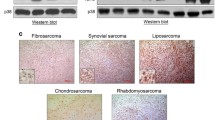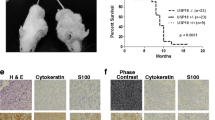Abstract
Nickel compounds are carcinogenic and induce malignant transformation of cultured cells. Since nickel has low mutagenic potential, it may act predominantly through epigenetic mechanisms, including down-regulation of tumor suppressor genes. FHIT is a tumor suppressor gene whose expression is frequently reduced or lost in tumors and pre-malignant lesions. Previously, we have shown that the phosphohydrolase activity of Fhit protein, associated with its tumor suppressor action, is inhibited by nickel [12]. In cells, such effect would assist in carcinogenesis. The latter could be further enhanced if nickel also lowered cellular levels of Fhit protein itself, e.g. by down-regulation of FHIT gene. To test this possibility, we determined Fhit protein and Fhit-mRNA levels in a nickel-transformed mouse cell line and in nickel-induced murine sarcomas. In B200 cells, derived by nickel treatment of BALB/c-3T3 cells and exhibiting a malignant phenotype, Fhit protein levels were 50% of those in the parental cells, while Fhit-mRNA expression remained unchanged. A decrease of up to > 90percnt; in Fhit protein levels was also observed in 22 local sarcomas (mostly fibrosarcomas) induced by i.m. injection of nickel subsulfide in C57BL/6 and MT+ (C57BL/6 overexpressing metallothionein) mice, as compared with normal muscles. Moreover, Fhit was absent in 3 out of 10 sarcomas from MT+ mice and in 1 of 12 sarcomas from C57BL/6 mice. The lack of Fhit protein coincided with the absence of the Fhit-mRNA transcript in these tumors. However, in the other tumors, the decreased Fhit levels were not always accompanied by reduced expression of Fhit-mRNA. Thus, the observed lowering of Fhit protein levels is mostly associated with changes in mRNA expression and protein translation or turnover rates, and rarely with a full silencing of the gene itself. Overall, the decline of Fhit in cells or tissues malignantly transformed by nickel may indicate possible involvement of this effect in the mechanisms of nickel carcinogenesis.
Similar content being viewed by others
References
Huebner K, Garrison PN, Barnes LD, Croce CM: The role of the FHIT/FRA3B locus in cancer. Annu Rev Genet 32: 7–31, 1998
Croce C, Sozzi G, Huebner K: Role of FHIT in human cancer. J Clin Oncol 17: 1618–1624, 1999
Werner NS, Siprashvili Z, Fong LY, Marquitan G, Schroder JK, Bardenheuer W, Seeber S, Huebner K, Schutte J, Opalka B: Differential susceptibility of renal carcinoma cell lines to tumor suppression by exogenous Fhit expression. Cancer Res 60: 2780–2785, 2000
Corbin S, Neilly ME, Espinosa R III, Davis EM, McKeithan W, Le Beau MM: FRA3B locus. Identification of unstable sequences within the common fragile site at 3p14.2: Implications for the mechanism of deletions within fragile histidine triad gene/common fragile site at 3p14.2 in tumors. Cancer Res 62: 3477–3484, 2002
Barnes LD, Garrison PN, Siprashvili Z, Guranowski A, Robinson AK, Ingram SW, Croce CM, Ohta M, Huebner K: Fhit, a putative tumor suppressor in humans, is a dinucleoside 5′,5‴-P1,P3-triphosphate hydrolase. Biochemistry 35: 11529–11535, 1996
Siprashvili Z, Sozzi G, Barnes L, McCue P, Robinson A, Eryomin V, Sard L, Tagliabue E, Greco A, Fusetti L, Schwatz G, Pierotti M, Croce C, Huebner K: Replacement of Fhit in cancer cells suppresses tumorigenicity. Proc Natl Acad Sci USA 94: 13771–13776, 1997
Chaudhuri AR, Khan IA, Prasad V, Robinson AK, Luduena RF, Barnes LD: The tumor suppressor protein Fhit. J Biol Chem 274: 24378–24382, 1999
Shi Y, Zou M, Farid NR, Paterson MC: Association of FHIT (fragile histidine triad), a candidate tumor suppressor gene, with the ubiquitin-conjugating enzyme hUBC9. Biochem J 352 Pt. 2: 443–448, 2000
Sard L, Accornero P, Tornielli S, Delia D, Bunone G, Campiglio M, Colombo MP, Gramegna M, Croce C, Pierotti MA, Sozzi G: The tumor-suppressor gene FHIT is involved in the regulation of apoptosis and in cell cycle control. Proc Natl Acad Sci USA 96: 8489–8492, 1999
Ji L, Fang B, Yen N, Fong K, Minna JD, Roth JA: Induction of apoptosis and inhibition of tumorigenicity and tumor growth by adenovirus vector-mediated fragile histidine triad. Cancer Res 59: 3333–3339, 1999
Brenner C, Bieganowski P, Pace HC, Huebner K: The histidine triad superfamily of nucleotide-binding proteins. J Cell Physiol 181: 179–187, 1999
Kowara R, Karaczyn A, Fivash MJ, Kasprzak KS: In vitro inhibition of the enzymatic activity of tumor suppressor FHIT gene product by carcinogenic transition metals. Chem Res Toxicol 15: 319–325, 2002
Kasprzak KS: Possible role of oxidative damage in metal-induced carcinogenesis. Cancer Invest 13: 411–430, 1995
Wang XW, Imbra RJ, Costa M: Characterization of mouse cell lines resistant to nickel(II) ions. Cancer Res 48: 6850–6854, 1988
Klaassen CD, Liu J: Metallothionein transgenic and knock-out mouse models in the study of cadmium toxicity. J Toxicol Sci 23(suppl 2): 97–102, 1998
Waalkes MP, Diwan BA, Kasprzak KS: Metal carcinogenesis in MT+ and MT− mice. Toxicol Appl Pharmacol (in press)
Pekarsky Y, Druck T, Cotticelli MG, Ohta M, Shou J, Mendrola J, Montgomery JC, Buchberg AM, Siracusa LD, Manenti G, Fong LY, Dragani TA, Croce CM, Huebner K: The murine Fhit locus: Isolation, characterization, and expression in normal and tumor cells. Cancer Res 58: 3401–3408, 1998
Palmiter RD, Sandgren EP, Koeller DM, Brinster RL: Distal regulatory elements from the mouse metallothionein locus stimulate gene expression in transgenic mice. Mol Cell Biol 13: 5266–5275, 1993
Iszard MB, Liu J, Liu Y, Dalton T, Andrews GK, Palmiter RD, Klaassen CD: Characterization of metallothionein-I-transgenic mice. Toxicol Appl Pharmacol 133: 305–312, 1995
Pekarsky Y, Palamarchuk A, Huebner K, Croce CM: FHIT as tumor suppressor: Mechanisms and therapeutic opportunities. Cancer Biol Ther 1: 232–236, 2002
Dumon KR, Ishii H, Fong LY, Zanesi N, Fidanza V, Mancini R, Vecchione A, Baffa R, Trapasso F, During MJ, Huebner K, Croce CM: FHIT gene therapy prevents tumor development in Fhit-deficient mice. Proc Natl Acad Sci USA 98: 3346–3351, 2001
Yang Q, Yoshimura G, Suzuma T, Tamaki T, Umemura T, Nakamura M, Nakamura Y, Wang X, Mori I, Sakurai T, Kakudo K: Clinicopathological significance of fragile histidine triad transcription protein expression in breast carcinoma. Clin Cancer Res 7: 3869–3873, 2001
Pavelic K, Krizanac S, Cacev T, Hadzija MP, Radosevic S, Crnic I, Levanat S, Kapitanovic S: Aberration of FHIT gene is associated with increased tumor proliferation and decreased apoptosis-clinical evidence in lung and head and neck carcinomas. Mol Med 7: 442–453, 2001
Morikawa H, Nakagawa Y, Hashimoto K, Niki M, Egashira Y, Hirata I, Katsu K, Akao Y: Frequent altered expression of fragile histidine triad protein in human colorectal adenomas. Biochem Biophys Res Commun 278: 205–210, 2000
Kitamura A, Yashima K, Okamoto E, Andachi H, Hosoda A, Kishimoto Y, Shiota G, Ito H, Kaibara N, Kawasaki H: Reduced Fhit expression occurs in the early stage of esophageal tumorigenesis: No correlation with p53 expression and apoptosis. Oncology 61: 205–211, 2001
Vasak M, Hasler DW: Metallothioneins: New functional and structural insights. Curr Opin Chem Biol 4: 177–183, 2000
Shimoda R, Nagamine T, Takagi H, Mori M, Waalkes MP: Induction of apoptosis in cells by cadmium: Quantitative negative correlation between basal or induced metallothionein concentration and apoptotic rate. Toxicol Sci 64: 208–215, 2001
Lima CD, D'Amico KL, Naday I, Rosenbaum G, Westbrook EM, Hendrickson WA: MAD analysis of FHIT, a putative human tumor suppressor from the HIT protein family. Structure 5: 763–774, 1997
Pace HC, Garrison PN, Robinson AK, Barnes LD, Draganescu A, Rosler A, Blackburn GM, Siprashvili Z, Croce CM, Huebner K, Brenner C: Genetic, biochemical, and crystallographic characterization of Fhit-substrate complexes as the active signaling form of Fhit. Proc Natl Acad Sci USA 95: 5484–5489, 1998
Kuehn K, Sunderman FW Jr: Dissolution half-times of nickel compounds in water, rat serum, and renal cytosol. J Inorg Biochem 17: 29–39, 1982
Kasprzak KS: Oxidative DNA damage in metal-induced carcinogenesis. In: L.W. Chang (ed). Toxicology of Metals. CRC Lewis Publishers, Boca Raton, FL, 1996, pp 299–320
Kasprzak KS: Oxidative DNA and protein damage in metal-induced toxicity and carcinogenesis. Free Radic Biol Med 32: 958–967, 2002
Bauman JW, Liu J, Klaassen CD: Production of metallothionein and heat-shock proteins in response to metals. Fundam Appl Toxicol 21: 15–22, 1993
Jourdan E, Emonet-Piccardi N, Didier C, Beani JC, Favier A, Richard MJ: Effects of cadmium and zinc on solar-simulated light-irradiated cells: Potential role of zinc-metallothionein in zinc-induced geno-protection. Arch Biochem Biophys 405: 170–177, 2002
Chimienti F, Jourdan E, Favier A, Seve M: Zinc resistance impairs sensitivity to oxidative stress in HeLa cells: Protection through metallothioneins expression. Free Radic Biol Med 31: 1179–1190, 2001
Bourdon E, Blache D: The importance of proteins in defense against oxidation. Antioxid Redox Signal 3: 293–311, 2001
Kasprzak KS, Hernandez L: Enhancement of hydroxylation and deglycosylation of 2′-deoxyguanosine by carcinogenic nickel compounds. Cancer Res 49: 5964–5968, 1989
Kasai H, Nishimura S: Hydroxylation of deoxyguanosine at the C-8 position by ascorbic acid and other reducing agents. Nucleic Acids Res 12: 2137–2145, 1984
Sunderman FW Jr: Carcinogenicity of nickel compounds in animals. In: IARC Scientific Publications, No. 53. Nickel in the Human Environment. IARC, Lyon, 1984, pp 127–142
Author information
Authors and Affiliations
Rights and permissions
About this article
Cite this article
Kowara, R., Salnikow, K., Diwan, B.A. et al. Reduced Fhit protein expression in nickel-transformed mouse cells and in nickel-induced murine sarcomas. Mol Cell Biochem 255, 195–202 (2004). https://doi.org/10.1023/B:MCBI.0000007275.22785.91
Issue Date:
DOI: https://doi.org/10.1023/B:MCBI.0000007275.22785.91




